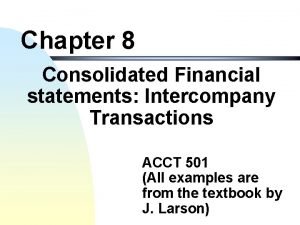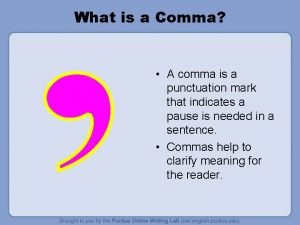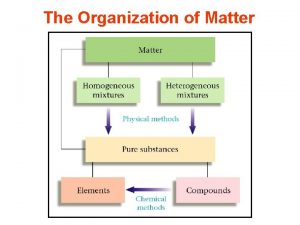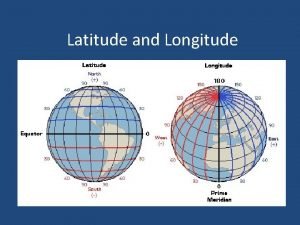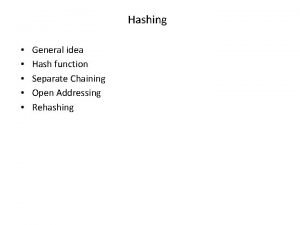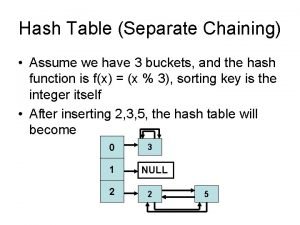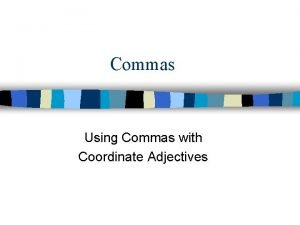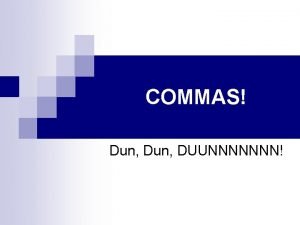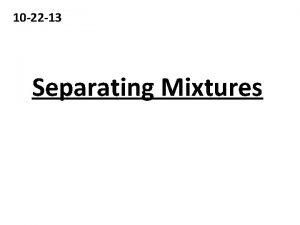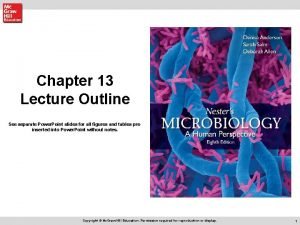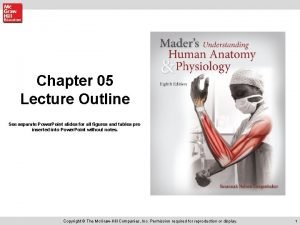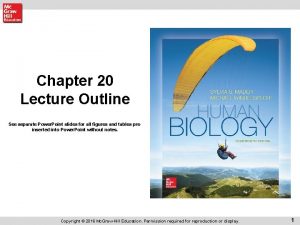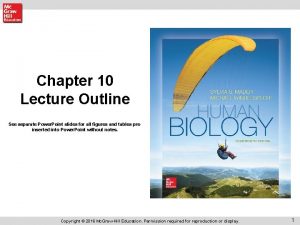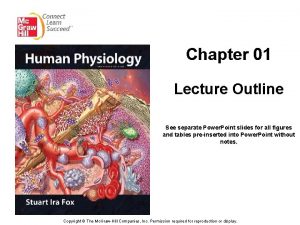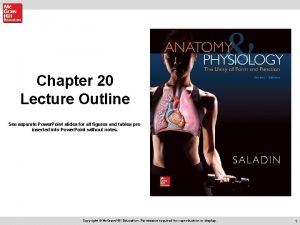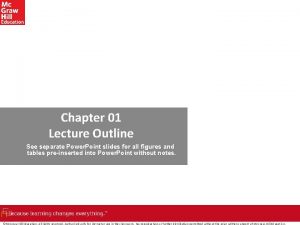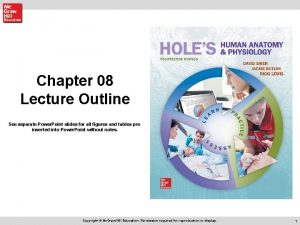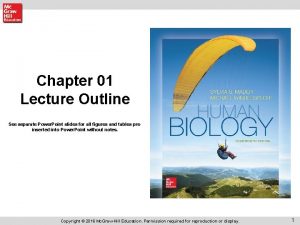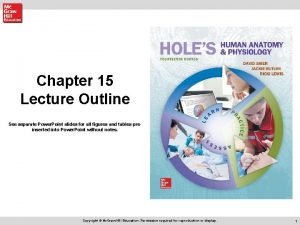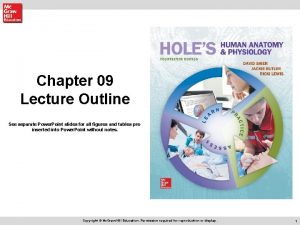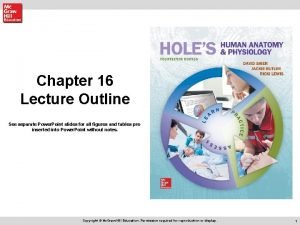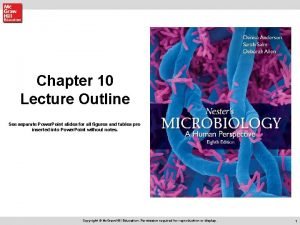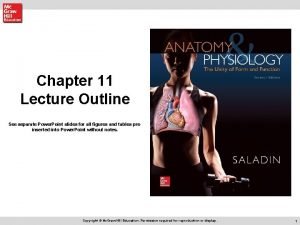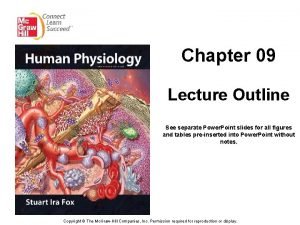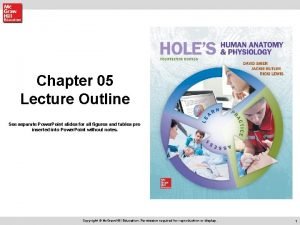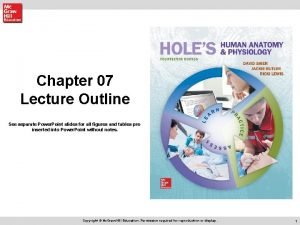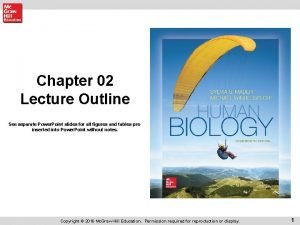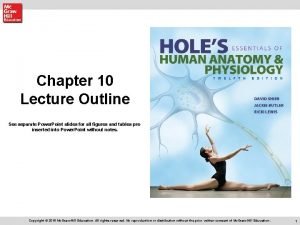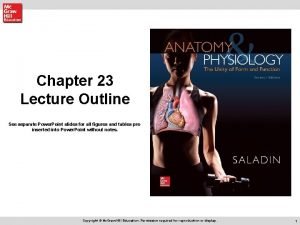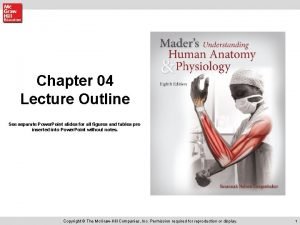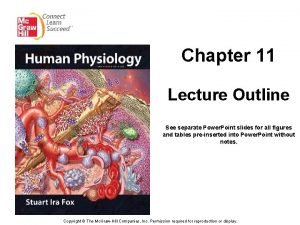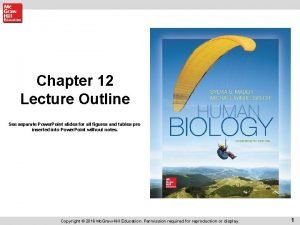Chapter 9 Lecture Outline See separate Power Point










































- Slides: 42

Chapter 9 Lecture Outline See separate Power. Point slides for all figures and tables preinserted into Power. Point without notes. Copyright © Mc. Graw-Hill Education. Permission required for reproduction or display. 1

Joints and Their Classification • Joint (articulation)— any point where two bones meet, whether or not the bones are movable at that interface Figure 9. 1 9 -2

Joints and Their Classification • Joint name—typically derived from the names of the bones involved (example: radioulnar joint) • Joints classified according to the manner in which the bones are bound to each other • Four major joint categories – – Bony joints Fibrous joints Cartilaginous joints Synovial joints 9 -3

Bony Joints • Bony joint, or synostosis—an immobile joint formed when the gap between two bones ossifies, and the bones become, in effect, a single bone – Examples: • Left and right mandibular bones in infants • Cranial sutures in elderly • Attachment of first rib and sternum with old age 9 -4

Fibrous Joints • Fibrous joint, synarthrosis, or synarthrodial joint—adjacent bones are bound by collagen fibers that emerge from one bone and penetrate into the other • Three kinds of fibrous joints – Sutures – Gomphoses – Syndesmoses 9 -5

Sutures Copyright © The Mc. Graw-Hill Companies, Inc. Permission required for reproduction or display. • Sutures—immobile or slightly mobile fibrous joints in which short collagen fibers bind the bones of the skull to each other Fibrous connective tissue Figure 9. 2 a 9 -6

Sutures Copyright © The Mc. Graw-Hill Companies, Inc. Permission required for reproduction or display. Figure 9. 3 Serrate suture Lap suture Dovetail joint Miter joint Plane suture Bone Wood Butt joint 9 -7

Gomphoses Copyright © The Mc. Graw-Hill Companies, Inc. Permission required for reproduction or display. Fibrous connective tissue • Gomphosis (fibrous joint)— attachment of a tooth to its socket Figure 9. 2 b (b) Gomphosis 9 -8

Syndesmoses Copyright © The Mc. Graw-Hill Companies, Inc. Permission required for reproduction or display. • Syndesmosis—a fibrous joint at which two bones are bound by long collagen fibers Fibrous connective tissue Figure 9. 2 c • Example of a very mobile syndesmosis: interosseus membrane joining radius to ulna allowing supination and pronation 9 -9 (c) Syndesmosis

Cartilaginous Joints • Cartilaginous joint, amphiarthrosis, or amphiarthrodial joint—two bones are linked by cartilage • Two types of cartilaginous joints – Synchondroses – Symphyses 9 -10

Synchondroses Copyright © The Mc. Graw-Hill Companies, Inc. Permission required for reproduction or display. • Synchrondrosis—bones joined by hyaline cartilage – Temporary joints in the epiphyseal plates in children Clavicle Sternum Rib 1 Costal cartilage (a) • Bind epiphysis to diaphysis Interpubic disc (fibrocartilage) (b) Pubic symphysis Figure 9. 4 a, b 9 -11

Symphyses • Symphysis—two bones joined by fibrocartilage Copyright © The Mc. Graw-Hill Companies, Inc. Permission required for reproduction or display. – Pubic symphysis joins right and left pubic bones with interpubic disc Intervertebral disc (fibrocartilage) – Bodies of vertebrae joined by intervertebral discs (c) Body of vertebra Interpubic disc (fibrocartilage) (b) Pubic symphysis Figure 9. 4 b, c 9 -12

Synovial Joints Copyright © The Mc. Graw-Hill Companies, Inc. Permission required for reproduction or display. • Synovial joint, diarthrosis, or diarthrodial joint—joint in which two bones are separated by a joint cavity • Most familiar type of joint • Most are freely mobile • Most structurally complex type of joint Proximal phalanx Ligament Joint cavity containing synovial fluid Articular cartilages Fibrous capsule Synovial membrane Periosteum Bone Joint capsule Middle phalanx Figure 9. 5 9 -13

General Anatomy of Synovial Joints • Articular cartilage—layer of hyaline cartilage that covers the facing surfaces of two bones – Usually 2 or 3 mm thick • Joint (articular) cavity—separates articular surfaces • Synovial fluid—slippery lubricant in joint cavity – – Rich in albumin and hyaluronic acid Gives it a viscous, slippery texture like raw egg whites Nourishes articular cartilage and removes waste Makes movement of synovial joints almost friction free 9 -14

General Anatomy of Synovial Joints • Joint (articular) capsule—connective tissue that encloses the cavity and retains the fluid – Outer fibrous capsule – Inner, cellular, synovial membrane 9 -15

Range of Motion • Range of motion (ROM)—the degrees through which a joint can move • ROM determined by: – Structure of the articular surfaces • Elbow—olecranon of ulna fits into olecranon fossa of humerus – Strength and tautness of ligaments and joint capsules • Stretching of ligaments increases range of motion • Double-jointed people have long or slack ligaments – Action of the muscles and tendons • Nervous system monitors joint position and muscle tone • Muscle tone—state of tension maintained in resting muscles 9 -16

Axes of Rotation Figure 9. 10 • Multiaxial joint—shoulder joint has three degrees of freedom or axes of rotation • Other joints are monoaxial or biaxial 9 -17

Classes of Synovial Joints Copyright © The Mc. Graw-Hill Companies, Inc. Permission required for reproduction or display. Ball-and-socket joint (humeroscapular) Head of humerus Hinge joint (humeroulnar) Scapula Ulna Radius Pivot joint (radioulnar) Plane joint (intercarpal) Ulna Saddle joint (trapeziometacarpal) Carpal bones Condylar joint (metacarpophalangeal) Carpal bone Metacarpal bone Phalanx Figure 9. 11 9 -18

Classes of Synovial Joints • Six classes of synovial joints: ball-and-socket, condylar, saddle, plane, hinge, pivot • Ball-and-socket joints – Smooth, hemispherical head fits within cup-like socket – Only multiaxial joints in body – Examples: shoulder, hip • Condylar (ellipsoid) joints – Oval convex surface of one bone fits into a complementary-shaped depression on the other – Biaxial joints—movement in two planes – Examples: radiocarpal joint, metacarpophalangeal joints 9 -19

Classes of Synovial Joints • Saddle joints – Both bones have an articular surface that is shaped like a saddle, one concave, the other convex – Biaxial joints – Examples: trapeziometacarpal (opposable thumb), sternoclavicular joint • Plane (gliding) joints – Flat articular surfaces, bones slide over each other – Usually biaxial joints – Examples: between carpal bones of wrist; between tarsal bones of ankle; also between articular processes of vertebrae 9 -20

Classes of Synovial Joints • Hinge joints – One bone with convex surface fits into a concave depression of another bone – Monoaxial joints—move freely in one plane – Examples: elbow, knee, joints within fingers, toes • Pivot joints – A bone spins on its longitudinal axis – Monoaxial joints – Examples: atlantoaxial joint (C 1 and C 2), radioulnar joint at the elbow 9 -21

Movement of Synovial Joints • Zero position—the position of a joint when a person is in the standard anatomical position – Joint movements described as deviating from the zero position or returning to it 9 -22

Flexion and Extension • Flexion—movement that decreases joint angle – Common in hinge joints • Extension—movement that straightens a joint and returns a body part to the zero position • Hyperextension—extension of a joint beyond the zero position – Flexion and extension occur at nearly all diarthroses, hyperextension is limited to a few Figure 9. 12 a Figure 9. 12 b 9 -23

Flexion and Extension Figure 9. 12 c Figure 9. 12 d 9 -24

Abduction and Adduction Figure 9. 13 a, b • Abduction—movement of a body part in the frontal plane away from the midline of the body – Hyperabduction: raise arm over back or front of head • Adduction—movement in the frontal plane back toward the midline – Hyperadduction: crossing fingers, crossing ankles 9 -25

Elevation and Depression Figure 9. 14 a, b • Elevation—movement that raises a body part vertically in the frontal plane • Depression—movement that lowers a body part in the same plane 9 -26

Circumduction • Circumduction—one end of an appendage remains stationary while other end makes a circular motion – Example: an artist circumducts upper limb when painting a circle on a canvas Figure 9. 16 9 -27

Rotation • Rotation—movement in which a bone spins on its longitudinal axis – Rotation of trunk, thigh, head, or arm • Medial (internal) rotation turns the bone inward • Lateral (external) rotation turns the bone outward Figure 9. 17 a, b 9 -28

Supination and Pronation • Primarily forearm movements • Supination—forearm movement that turns palm to face anteriorly or upward – Forearm supinated in anatomical position – Radius is parallel to the ulna • Pronation—forearm movement that turns palm to face either posteriorly or downward – Head of radius spins – Radius crosses stationary ulna like an X Figure 9. 18 a, b 9 -29

Special Movements of Head and Trunk Figure 9. 19 a, b, c • • Flexion—forward-bending movements at the waist or neck Extension—straightens trunk or neck Hyperextension—bending over backward Lateral flexion—tilting the head or trunk to the right or left at the midline 9 -30

Special Movements of Head and Trunk Figure 9. 19 d, e • Right and left rotation of trunk and head 9 -31

Special Movements of the Foot Figure 9. 22 • Dorsiflexion—elevating toes as you do while swinging foot forward to take a step (heel strike) • Plantar flexion—extending foot so that toes point downward as in standing on tiptoe (toe-off) • Inversion—movement in which the soles are turned medially • Eversion—movement in which the soles are turned laterally 9 -32

The Shoulder Joint • Glenohumeral (humeroscapular) joint— hemispherical head of humerus articulates with glenoid cavity of scapula – Most freely mobile joint in body Copyright © The Mc. Graw-Hill Companies, Inc. Permission required for reproduction or display. Acromion Supraspinatus tendon Subdeltoid bursa Capsular ligament Glenoid labrum Deltoid muscle Synovial membrane Glenoid cavity of scapula Glenoid labrum Humerus (c) Frontal section Figure 9. 24 c 9 -33

The Shoulder Joint • Shoulder supported by biceps brachii tendon anteriorly and also rotator cuff tendons – Supraspinatus, infraspinatus, teres minor, and subscapularis Copyright © The Mc. Graw-Hill Companies, Inc. Permission required for reproduction or display. Acromion Supraspinatus tendon Subdeltoid bursa Capsular ligament Glenoid labrum Deltoid muscle Synovial membrane Glenoid cavity of scapula Glenoid labrum Humerus (c) Frontal section Figure 9. 24 c 9 -34

The Elbow Joint • Elbow—a hinge that includes two articulations: – Humeroulnar joint: trochlea of the humerus joins trochlear notch of the ulna – Humeroradial joint: capitulum of humerus meets head of radius Copyright © The Mc. Graw-Hill Companies, Inc. Permission required for reproduction or display. Joint capsule Humerus Coronoid process Trochlea Olecranon bursa Articular cartilage Radius Olecranon Ulna (b) Sagittal section Figure 9. 25 b Copyright © The Mc. Graw-Hill Companies, Inc. Permission required for reproduction or display. Humerus Anular ligament Tendon of biceps brachii (cut) Joint capsule Radius Tendon of triceps brachii Ulnar collateral ligament Coronoid process Olecranon bursa Ulna Figure 9. 25 c (c) Medial view 9 -35

The Hip Joint Copyright © The Mc. Graw-Hill Companies, Inc. Permission required for reproduction or display. Round ligament (cut) Fovea capitis Acetabulum Head of femur Greater trochanter Labrum Ischial tuberosity Femur Obturator membrane Transverse acetabular ligament • Coxal (hip) joint—head of femur inserts into acetabulum of hip bone • Bears weight, has deeper sockets, more stable than shoulder (b) Lateral view, femur retracted Figure 9. 26 b 9 -36

The Hip Joint Copyright © The Mc. Graw-Hill Companies, Inc. Permission required for reproduction or display. Ilium Iliofemoral ligament Ischiofemoral ligament Pubofemoral ligament Iliofemoral ligament Pubis Greater trochanter Ischial tuberosity Femur Lesser trochanter Femur (c) Anterior view Figure 9. 26 c, d (d) Posterior view 9 -37

The Knee Joint • Tibiofemoral (knee) joint—largest and most complex diarthrosis of the body • Primarily a hinge joint – Patellofemoral joint— gliding joint Figure 9. 29 a 9 -38

The Knee Joint Figure 9. 29 9 -39

Arthritis and Artificial Joints • Arthritis—a broad term for pain and inflammation of joints • Most common crippling disease in the United States • Rheumatologists—physicians who treat arthritis and other joint disorders • Osteoarthritis (OA)—most common form of arthritis – – – “Wear-and-tear arthritis” Results from years of joint wear Articular cartilage softens and degenerates Accompanied by crackling sounds called crepitus Bone spurs develop on exposed bone tissue causing pain 9 -40

Arthritis and Artificial Joints • Rheumatoid arthritis (RA)—autoimmune attack against the joint tissues – Misguided antibodies (rheumatoid factor) attack synovial membrane, enzymes in synovial fluid degrade the articular cartilage, joint begins to ossify – Ankylosis: solidly fused, immobilized joint – Remissions occur, steroids and aspirin control inflammation 9 -41

Rheumatoid Arthritis Figure 9. 32 a, b 9 -42
 Essay writing c
Essay writing c 01:640:244 lecture notes - lecture 15: plat, idah, farad
01:640:244 lecture notes - lecture 15: plat, idah, farad Real power formula
Real power formula Informsu
Informsu Point point power
Point point power Lecture outline example
Lecture outline example Lecture outline example
Lecture outline example Lecture outline example
Lecture outline example Lecture outline meaning
Lecture outline meaning Quote sandwich paragraph example
Quote sandwich paragraph example A separate peace chapter 1
A separate peace chapter 1 Intercompany bond transactions
Intercompany bond transactions Power system dynamics and stability lecture notes
Power system dynamics and stability lecture notes Power system analysis lecture notes
Power system analysis lecture notes Power semiconductor devices lecture notes
Power semiconductor devices lecture notes Switch mode power supply lecture notes
Switch mode power supply lecture notes Power system dynamics and stability lecture notes
Power system dynamics and stability lecture notes Customs in things fall apart
Customs in things fall apart 5 paragraph
5 paragraph Management fifteenth edition
Management fifteenth edition Human resource management chapter 1
Human resource management chapter 1 Human resource management lecture chapter 1
Human resource management lecture chapter 1 Comma description
Comma description Separate result unknown
Separate result unknown Separation of mixtures
Separation of mixtures How to separate raisins and flour
How to separate raisins and flour How to separate salt and sand chemistry
How to separate salt and sand chemistry Accompaniment salad definition
Accompaniment salad definition Supporting bill
Supporting bill Separate result unknown
Separate result unknown Important lines of latitude and longitude
Important lines of latitude and longitude Chet douglass a separate peace
Chet douglass a separate peace Separate chaining rehash
Separate chaining rehash Separate chaining
Separate chaining Is english language and literature two separate gcses
Is english language and literature two separate gcses Living things grow images
Living things grow images Coordinate and cumulative adjectives
Coordinate and cumulative adjectives Commas around in fact
Commas around in fact When to use a comma in a list of items
When to use a comma in a list of items Commas to separate adjectives
Commas to separate adjectives Cognitively guided instruction
Cognitively guided instruction A separate peace setting
A separate peace setting How to separate salt and sand chemistry
How to separate salt and sand chemistry











